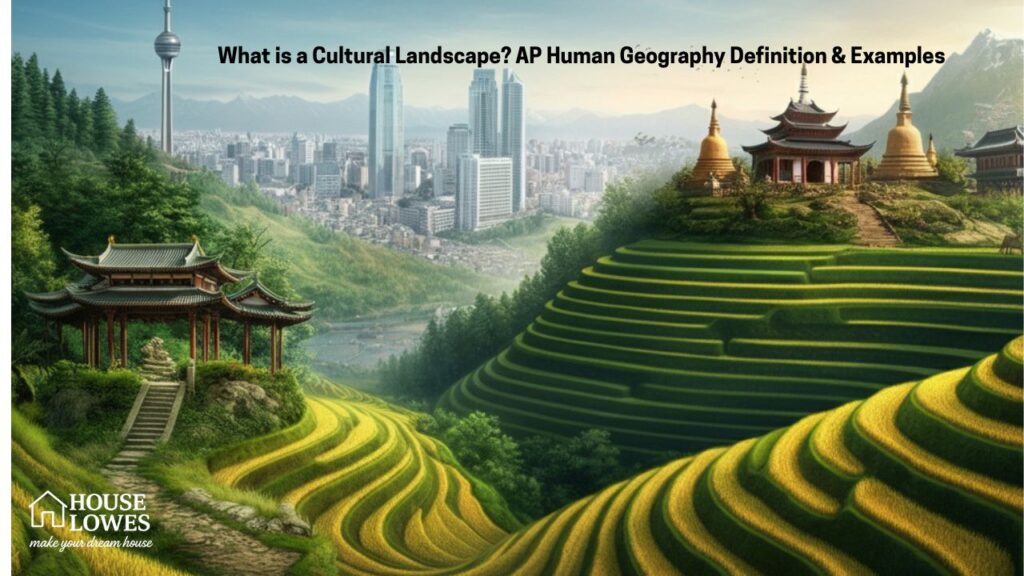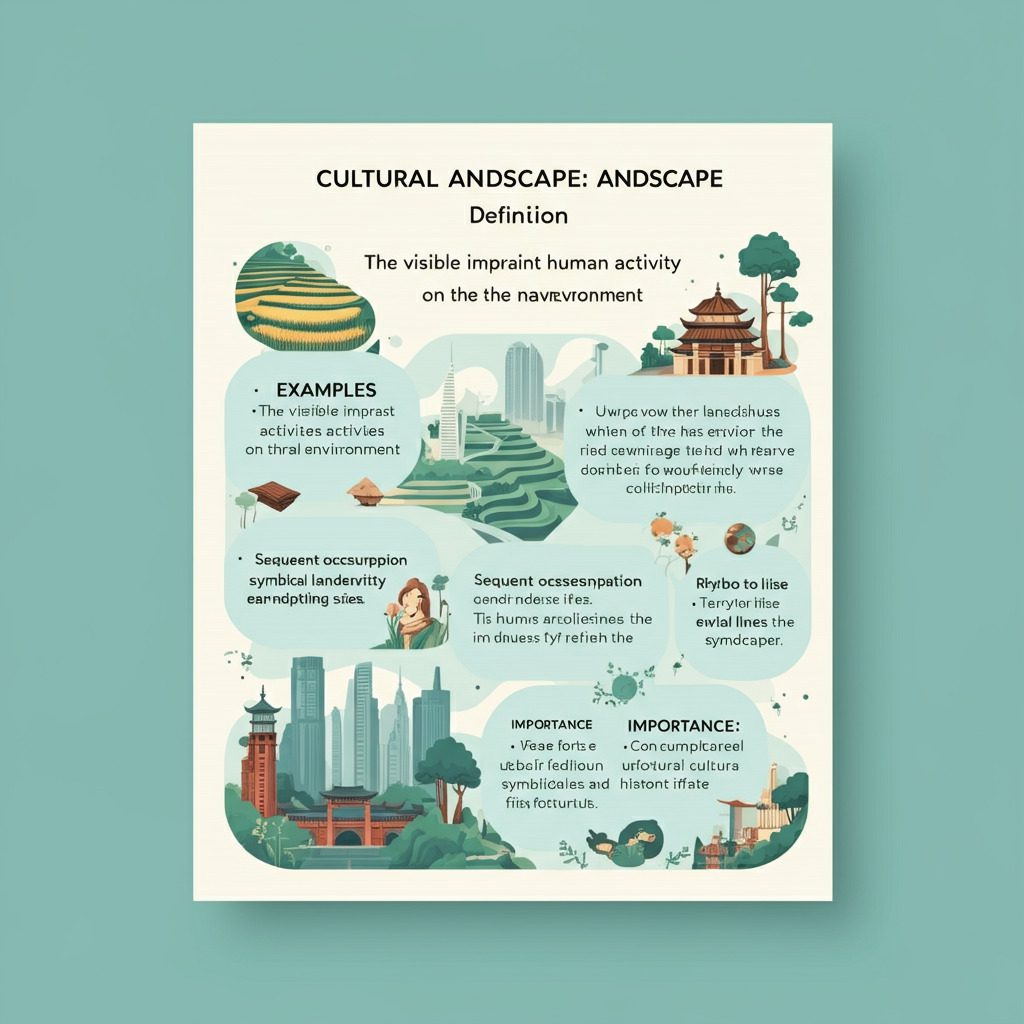Have you ever looked at your surroundings and wondered, “What story does this place tell about the people who live here?” All around us, from the bustling cities with their towering skyscrapers to quiet farmlands with neat rows of crops, we see evidence of how humans interact with their environment. This relationship between culture and the natural world creates something called a “cultural landscape.” If you’re exploring AP Human Geography, stick with me. I’ll break this down into simple, relatable bits so it feels like we’re just chatting about the world and its hidden cultural stories.

What’s a Cultural Landscape, Anyway?
Picture this. You walk through a neighborhood and see mosques with intricate domes, next door to sprawling markets where vendors sell spices and colorful fabrics. This isn’t just any random arrangement of buildings and people. It’s a cultural landscape! To put it simply, a cultural landscape is a way of describing the places that humans have shaped based on their beliefs, traditions, and needs. It’s like a natural canvas painted with culture and history.
Here’s an easy way to think about it. Imagine you’re looking at land, and every building, field, road, or park you see tells a story. That’s what “cultural landscape” means in AP Human Geography. It’s studying the visible impact of humans on the land.
Whether it’s the vineyards in France that reflect centuries of winemaking traditions or the Golden Gate Bridge showcasing architectural ambition, cultural landscapes reflect how humans shape their environment to meet their needs and celebrate their identities. Cool, right?
If we’re talking definitions, AP Human Geography has its own spin. The cultural landscape definition in AP Human Geography would go something like this: It’s how we see the world around us, molded by human activity. Or, the cultural landscape AP Human Geography simple definition might be this: it’s how culture leaves its footprint on nature.

Why Are Cultural Landscapes Important?
Okay, so why should we care? You might ask yourself, “Why spend time analyzing buildings, fields, and marketplaces?” Great question. Cultural landscapes matter because they tell the story of people and places. Each one of us leaves marks on our environment, whether small or big. When we zoom out and study these marks on a larger scale, we learn about traditions, beliefs, and even the struggles of populations.
Take the religious cultural landscape definition AP Human Geography for example. Religious sites like temples, shrines, or even cemeteries are more than just places tied to beliefs. They connect us to the hopes, fears, and aspirations of people across time. Think of the vast mosque courtyards in Turkey with beautiful carvings or Catholic cathedrals in France. They’re vivid examples of how religion has stamped its presence onto the land.
Cultural landscapes also help us understand change. People move; beliefs evolve. Migration, trade, and globalization introduce new ways of doing things, blending colors onto this canvas of culture. That’s why studying the definition of cultural landscape AP Human Geography gives us insight into why a place looks the way it does today.
How Do We See These Landscapes?
Now, here’s where it gets exciting. The cultural landscape approach definition AP Human Geography encourages us to see the world through a specific lens. Instead of just seeing fields and highways, we ask questions. Why is that field here? Who decided on that highway’s location? Cultural landscapes are like puzzles where humans are the creators and changers.
For example:
- Sequent Occupancy – Places like Mexico City have layers of history. Beneath modern skyscrapers, ruins of the Aztec empire still sit. This idea says cultural landscapes stack over time, like a cake!
- Symbolic Landscapes – Think of the Statue of Liberty. It’s not just a statue; it’s a symbol of freedom and hope. These landscapes are dripping with meaning.
- Patterned Landscapes – Agricultural terraces like those you’ll find in Southeast Asia show humans maximizing challenging terrain for farming. You can see creativity and survival at work.
What does this mean for students like you? Learning these concepts makes it easier to give examples when exam time comes.
Cultural Landscapes You Already Know About
You’ve seen cultural landscapes everywhere, even if you didn’t call them that. A football field, for instance, with school banners and bleachers, reflects human activities (sports activities, school identity). Farmlands, on the other hand, reflect agriculture and resource use. Even crowded downtown streets with their neon signs and fast-food chains show how economic forces shape land use.
- A cultural landscape AP Human Geography definition and example would be the rice paddies in Asia. They’re not just farmlands but also reflections of centuries-old traditions in farming.
- Another example? Look at the peaceful parks in urban cities, showing how humans carve out little spaces for nature in the middle of congestion.
Fun Connection to Real Life
Think about video games (yes, I’m serious). Games like Minecraft or SimCity allow players to manipulate a landscape. Want to build a farming town with a castle overlooking it? Go ahead! Want to build a futuristic city where everyone uses flying cars? Sure thing! These simulated cultural landscapes mirror what actual humans have been doing since forever. They create, adjust, and sometimes rebuild landscapes to fit their culture.
By looking at cultural landscapes, we don’t just study geography. We get a window into how humans think and what they value.
Key Takeaways for AP Students
If you’re an AP Human Geography student, here are three things you should memorize about cultural landscapes:
- Definition Reminder – The AP Human Geography definition for cultural landscape focuses on how humans change the environment to reflect their culture.
- Examples Shine – Use examples in your answers. Think mosques, skyscrapers, farms, and even shopping malls.
- Ask Why – When you study a place, always ask why it looks the way it does. That’s how you nail those exam questions.
FAQs About Cultural Landscapes
What is a cultural landscape simple definition AP Human Geography?
It’s how land is shaped by human culture. Think of something like farmland or a city that’s been built by humans to reflect their lifestyle.
Why do AP students need to understand cultural landscapes?
Cultural landscapes show how people and the environment interact. They also reveal changes over time which is a key topic in AP exams.
Can you give an AP Human Geography cultural landscape definition and example?
Sure! A cultural landscape is any space altered by humans, like a rural town or a big city. A good example is New York City’s skyline, filled with skyscrapers representing economic success.
What’s the easiest way to spot a cultural landscape?
Look for human activity! Roads, houses, or even a simple playground are part of a cultural landscape.
Wrapping It Up
Cultural landscapes aren’t just about what we see. They’re about the stories they tell and the people who shape them. Whether you’re walking through an ancient city or reading a definition from your AP Human Geography textbook, remember this simple idea. These landscapes are history and culture molded into something we can touch, climb, or just sit and marvel at.
Oh, and one last thing before we move to the next section, when you look around today, ask yourself this little question: “What does this place say about its people?” I bet you’ll never look at a place the same way again!
Admin Recommendation
Cultural Landscapes in AP Human Geography | Comprehensive Gui
Transform Frederick Yards with Innovative Landscaping Designs
Types of Brown Landscape Rocks | Find the Perfect Fit for Your Yard
Foundation of Landscaping: Landscape Uses of Trees, Shrubs & Climbers








